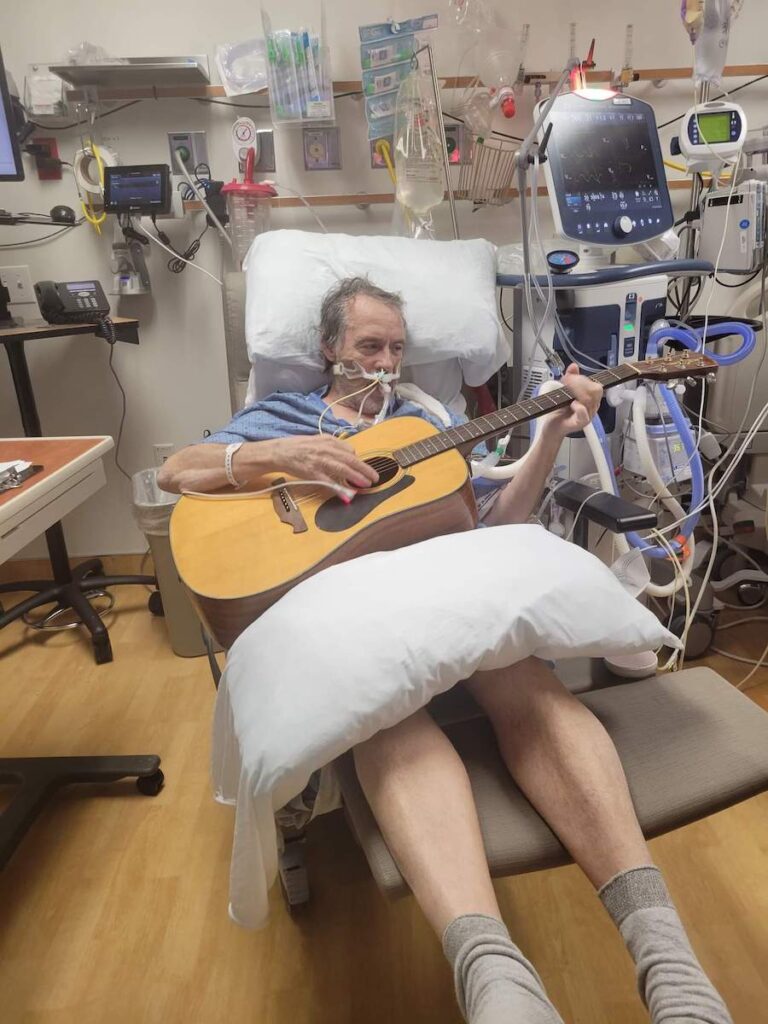When I think back to how I started my career as a nurse, it really does seem like a date with destiny.
I could have gotten a job at any ICU, but for whatever reason, I landed my first nursing gig at a high acuity medical-surgical intensive care unit in Salt Lake City, Utah, which just so happened to be an Awake and Walking ICU.
While I was interviewing for the job, the nurse manager asked me if I’d be willing to help patients mobilize during mechanical ventilation.
At the time, I had no idea what that meant, but I enthusiastically nodded my head and said, “Yes. Of course!”
Little did I know that this first nursing job would lead me down a path toward what I now feel is my life’s purpose, and it’s so inspiring to reminisce about how things have played out since that fateful day.
In any case, standard practice in this Awake and Walking ICU was to allow patients to wake up right after intubation and mobilize shortly thereafter, unless there was an indication that the patient needed to be comatose, or a contraindication to mobility.
Otherwise, intubated patients would always be up and cruising around.
At this point, you might be thinking that this doesn’t sound like a real high acuity ICU, or that these patients were all on the ventilator long-term, but nothing could be further from the truth.
Even during COVID, they insisted on allowing patients to mobilize while intubated, unless there was a need for them to be sedated, or they couldn’t oxygenate with movement.
And believe it or not, this ICU team went over two years without a single unplanned extubation.
But why is that?
Well, with any luck, you already know the answer, but if you’re not quite certain, or you just want to learn the truth about unplanned extubations, then you should definitely keep reading.
Unplanned Extubations and the ABCDEF Bundle

The main reason why this ICU was able to go so long without an unplanned extubation is that it adheres to the evidence-based practices in the ABCDEF Bundle.
This set of tools is meant to help clinicians customize and optimize patient care, particularly when it comes to early mobility, delirium prevention, and limiting sedation.
If you work in the intensive care unit, then I hope you’ve heard of it, but sadly, in spite of all its benefits, it’s not as well-known as it should be.
So, for the benefit of those of you who aren’t familiar with it, I’m going to explain how it works.
The ABCDEF Bundle works by prioritizing:
- Family members being involved, which improves patients’ overall well-being and creates a need for them to be awake and communicative
- Early active mobility, meaning patients will be able to get up and walk around while intubated, unless there’s a contraindication
- Delirium prevention, assessment, and treatment, with the focus being put on prevention, which goes hand in hand with early mobility, as it’s known to prevent delirium
- Considering our choice of sedation and analgesia, which not only encourages us to limit the use of benzodiazepines, but also to determine if sedation is even needed, and if it is, to always go with the safest sedative, at the lowest dose, and for the shortest duration
- Both spontaneous breathing and awakening trials, which help clinicians to make a better assessment of exactly what a patient needs, while considering any delirium they’re experiencing and how best to treat it
- Assessment, prevention, and treatment of pain, which is much easier when patients have not been sedated, and are actually able to communicate their needs, and what sort of pain they’re experiencing
These practices also encourage clinicians to avoid restarting sedation as soon as they witness a patient with delirium or agitation. This perspective helps them to understand that sedation is often responsible for patients being delirious or agitated, so it’s best not to sedate them unless it’s absolutely necessary.
The image below offers a perfect example of how beneficial these practices can be, as more than likely, the only reason that this man, who was a COVID patient, was able to remain awake long after being intubated, and still have enough energy to strum a guitar, is that he was treated using the practices outlined in the ABCDEF Bundle.

If you want to learn more about the ABCDEF Bundle, and the devastating effects of not adhering to these evidence-based practices, you can read my article on Susanne’s Story: How to Improve ICU Patient Outcomes with the ABCDEF Bundle.
And if you’d like to learn even more about unplanned extubations, you should check out Episode 112 of my Walking Home From The ICU podcast.
The Unnecessary Fear Surrounding Unplanned Extubations
Unfortunately, for many ICU clinicians, the idea of having patients awake and mobile while on the ventilator is actually quite scary.
What I often hear from clinicians who are skeptical of these practices is that they believe they’re unsafe because the patient could extubate themselves.
Now, unplanned extubations are a legitimate thing for clinicians to be concerned about, and they can have dire consequences, including everything from hypoxemia and hypotension to respiratory failure, aspiration pneumonia, or even death.
But when we look at the evidence, it’s actually very rare for an unplanned extubation to take place as a result of early mobility. One meta-analysis that included over 14,000 activity sessions showed a rate of adverse events, such as cardiac arrhythmias, hypoxia, hypotension, falls, and unplanned extubations, of just 0.6 percent.
And when we compare this to something as innocuous as bed baths, for instance, where unplanned extubations are one of the most common events, this is when things really get put into context, and we realize that the fear of unplanned extubations happening during mobilization is completely blown out of proportion.
Sure, unplanned extubations can happen while a patient is ambulating, and this can cause serious complications, but it’s no more likely to happen during early mobility than it is during many other routine practices in the ICU. In fact, it’s quite the contrary.
So, which one of these practices is more dangerous in the context of unplanned extubations? Bed baths or early mobility? I think the answer is obvious, but I’ll let you be the judge.
And when we look at the risk factors for unplanned extubations, this is when everything starts to make sense, and we realize that delirium is one of the main reasons why these unfortunate events occur.
In fact, several of the risk factors for unplanned extubations are directly related to patients experiencing delirium, and how they got into that state in the first place.
Some of these risk factors include patients’ restlessness and agitation, the use of Midazolam to decrease that agitation, the use of physical restraints, which has a correlation with delirium, and issues related to nursing staff, such as inexperience and inadequate staffing.
And when I think about the fact that I’ve personally witnessed thousands of patients who were awake and mobile on the ventilator, and these situations almost never resulted in an unplanned extubation, I realize how important it is for me to relate these risk factors to what I’ve experienced in the ICU.
Because in my experience, unplanned extubations have tended to occur when patients are restrained, and when they were restrained, it’s because they were delirious.
Aside from my own observations, this is also shown in the literature on unplanned extubations, especially when you look at newer studies on this topic.
For example, an Asian Nursing Research study from 2017 found delirium and agitation to be two of the biggest risk factors for unplanned extubations in critically ill patients, with delirium increasing unplanned extubations by 11.6 times, and agitation increasing them by nine times.
Still, even today, in spite of this kind of research being widely available, clinicians don’t seem to understand the seriousness of delirium, or the risk factors that can go along with it.
But the fact of the matter is delirium is a symptom of acute brain failure, and a life-threatening medical emergency.
That being said, there are many different reasons why delirium occurs, and despite the good intentions of clinicians, unfortunately, we often contribute to the development of delirium with many of the outmoded protocols that are still being practiced in ICUs to this day.
For instance, when sedating a patient, many clinicians believe that this is the most benevolent and humane thing they can do. The prevailing ICU culture has led them to believe that sedation is sleep, and that sedated patients are as calm and comfortable as they appear to be as they lie motionless in their beds.
But this just isn’t true. And if you look at the research, and listen to the agonizing stories of patients who’ve gone through the experience of being sedated for long periods of time, you’ll learn that sedation is not sleep, and it’s not sparing patients the stress and trauma of being in the intensive care unit.
On the contrary, it’s actually a form of sleep deprivation, and one that’s known to cause trauma, not mitigate its impact.
The truth is, the experience of being sedated can be incredibly traumatic for patients, many of whom experience horrible nightmares, or worse, for days and weeks on end as they remain sedated, and this is yet another reminder of why we should never sedate a patient unless it’s absolutely necessary.
I’ve documented the testimony of many patients who’ve experienced this for themselves, and if you’d like to hear some of their stories, you can skip to the 17-minute mark in the video below.
The Costs of Delirium in the ICU

Regardless of all the well-intentioned, yet erroneous beliefs about sedation that still persist in ICU culture today, the fact is, sedation is known to cause delirium, and patients with delirium are:
- Three times as likely to die within six months after discharge, and with each day of delirium, there is a 10 percent increase in their risk of death (Ely, 2004)
- Likely to spend more time in the ICU, and more time hospitalized (Dziegielewski, 2021)
- Prone to increased time on the ventilator (Arumugam, 2017)
- At increased risk of line and tube removals (Tilouche, 2018)
- More likely to die one year after discharge (Pisani, 2009)
- Less likely to discharge from the ICU (Klouwenberg, 2014)
- Two times as likely to die during admission (Salluh, 2015)
What’s more, failing to manage delirium can also create serious consequences for our healthcare system, as well as individual ICUs and the clinicians who work in them, including:
- Increased risk of workplace violence from patients experiencing delirium (Jakobsson, 2020)
- Higher healthcare system costs of up to $152 billion per year (Leslie, 2008)
- Up to 39 percent higher intensive care unit costs (Milbrandt, 2004)
- Increased workload for clinicians (Sieber, 2021)
So, as you can see, by following outdated practices, like deeply sedating all ICU patients, we’re not doing them any favors. We’re actually putting them at a much greater risk of suffering from delirium, and all the risk factors that go along with it, like unplanned extubations.
And as clinicians, we’re not doing ourselves, our industry, or our reputations any favors either.
Now, before I conclude, I’d like to summarize a story from Dr. Wes Ely, who is the creator of the ABCDEF Bundle.
This anecdote involves a 27-year-old wheelchair-bound patient who had returned to an ICU where Dr. Ely was visiting after having been there two years prior for bleeding in her lungs.
The reason she was in a wheelchair is that as a result of being sedated and immobile for so long in the ICU, she had suffered severe muscle loss in her legs and could no longer walk, even two years later.
Dr. Ely asked the clinicians who treated her why they kept her sedated and in bed for so long, and they said they were afraid she would self-extubate, to which another doctor asked, “But what if she never walks again?”
It’s stories like this that show just how important it is to avoid sedating ICU patients whenever possible, and how blown out of proportion our fears about unplanned extubations truly are.
With that in mind, I’ll conclude by saying that although unplanned extubations are a legitimate concern, we should not fear things like early mobility. What we should be afraid of are outdated practices like automatically sedating every patient who comes into the ICU, or keeping patients sedated for long periods of time.
Because sedation and immobility are the main modifiable causes of delirium in the ICU, and when it comes to unplanned extubations, delirium is one of the most well-known culprits.
But by doing whatever we can to prevent ICU delirium, we can keep patients safe from the risks of unplanned extubations.
Are you interested in implementing the ABCDEF Bundle in your ICU? We can walk you through the entire process, so please don’t hesitate to contact us.



 When patients are so ill that they require a ventilator in the ICU, the antiquated approach of heavy sedation and immobilization should be avoided in order to help prevent the immense burden of physical and cognitive disabilities suffered during survival. To understand this better, listen to Walking Home From The ICU. You will see what ICU consultant Kali Dayton provides to your team.
When patients are so ill that they require a ventilator in the ICU, the antiquated approach of heavy sedation and immobilization should be avoided in order to help prevent the immense burden of physical and cognitive disabilities suffered during survival. To understand this better, listen to Walking Home From The ICU. You will see what ICU consultant Kali Dayton provides to your team.
